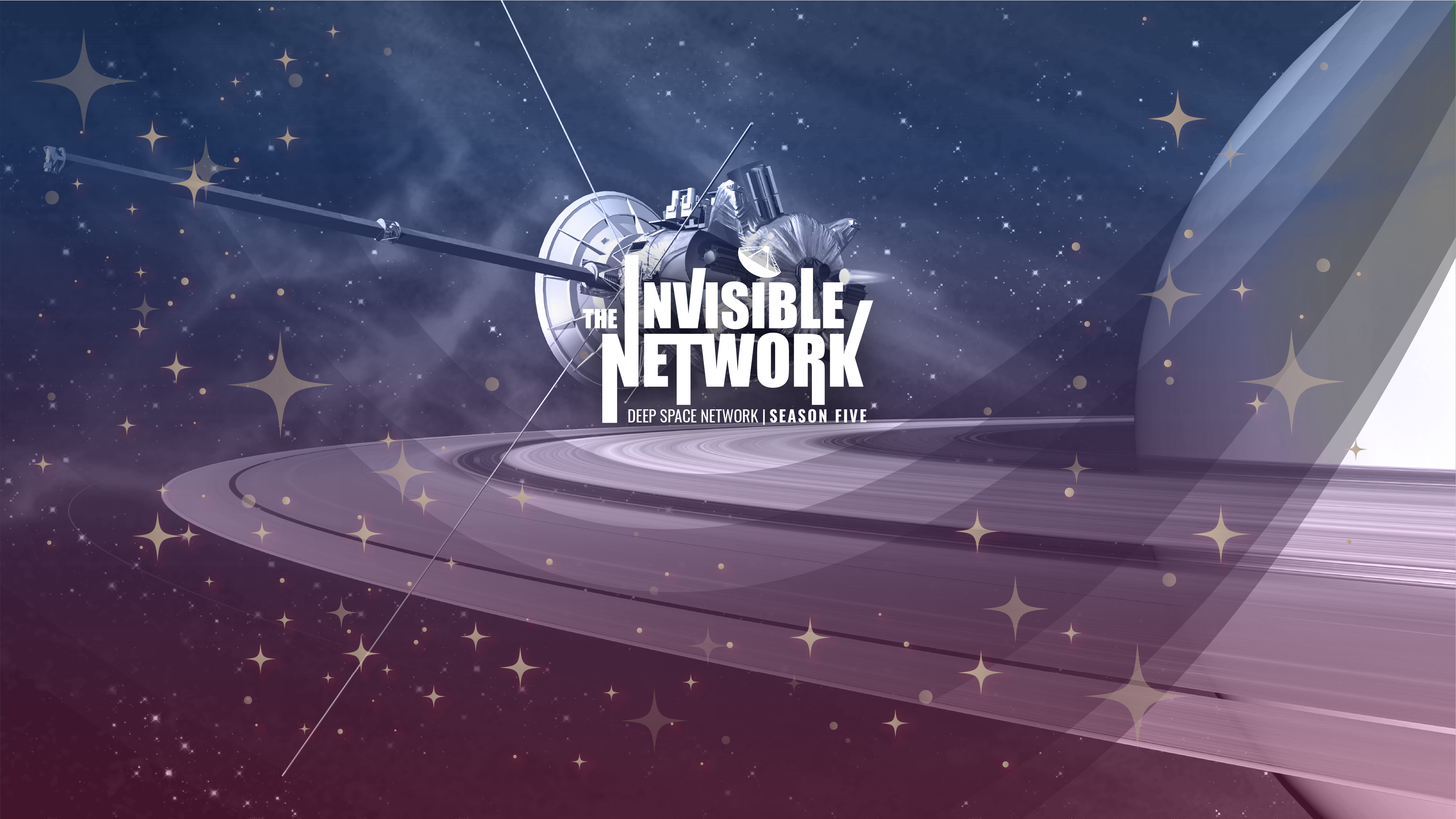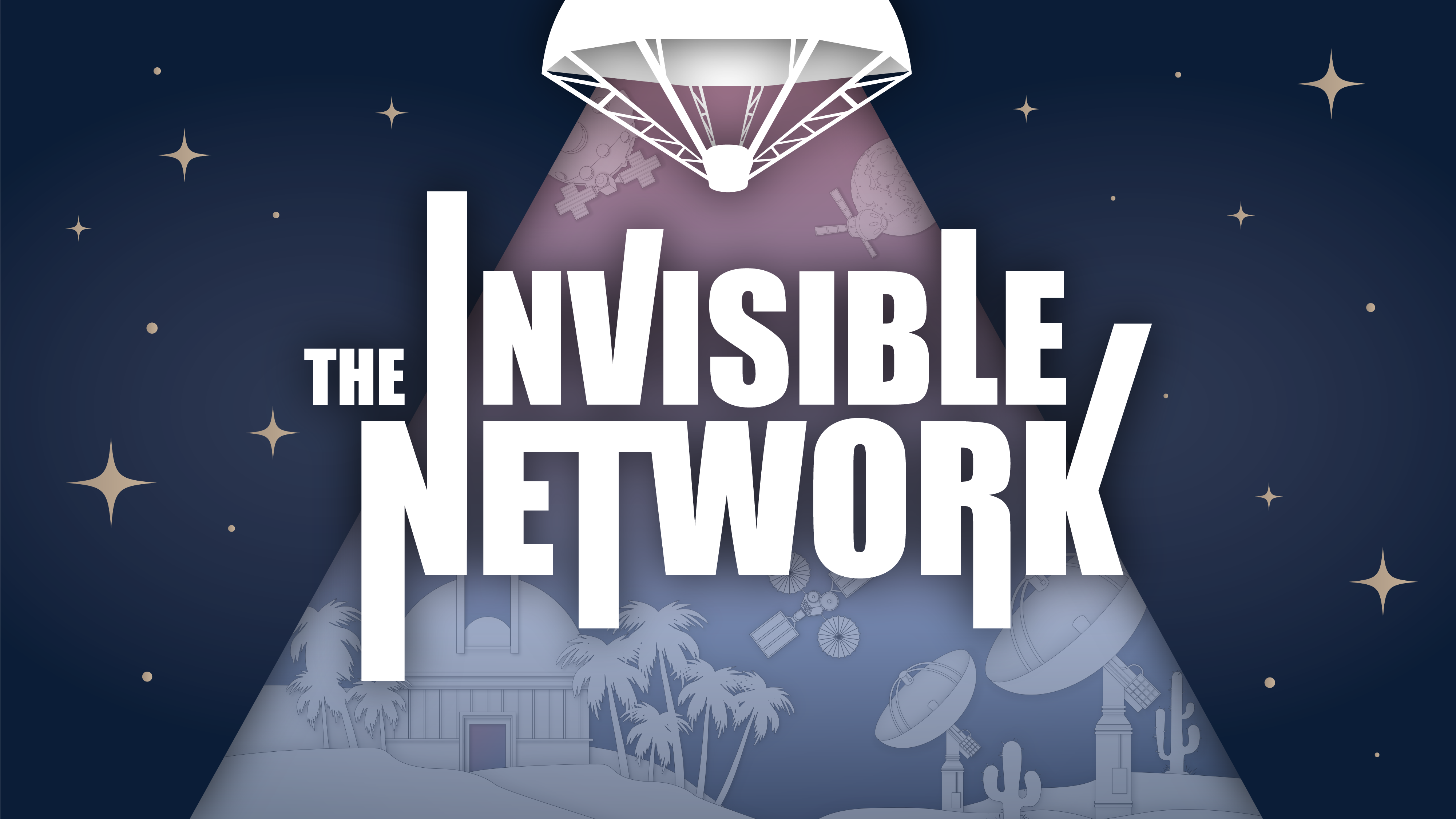
NARRATOR
To close out our Deep Space Network-focused season of NASA’s The Invisible Network podcast, we solicited your questions about the network with the hashtag #AskSCaN on social media. We really appreciate all the great input we received! In this bonus episode, we’re going to answer four fun questions from our listeners, pairing them with a subject matter expert who can provide the context we need to better understand the contributions that network capabilities provided by the Jet Propulsion Laboratory and NASA’s Space Communications and Navigation program offer deep space missions!
I’m Danny Baird, this is “The Invisible Network.”
…
A collage of historical audio
PRESIDENT JOHN F. KENNEDY
We choose to go to the Moon in this decade…
NEIL ARMSTRONG(Apollo 11)
That’s one small step for (a) man…
COMMENTATOR(Voyager Launch)
We have ignition, and we have lift off!
CHILD FROM VOYAGER GOLDEN RECORDS
Hello from the children of planet Earth…
COMMENTATOR(Cassini Launch)
Three… two… one… and liftoff, of the Cassini spacecraft…
COMMENTATOR(Perseverance Landing)
Touchdown confirmed, Perseverance safely on the surface of Mars…
Theme music fades.
…
LES DEUTSCH
My name is Dr. Les Deutsch, and I’m the deputy director of [the] Interplanetary Network Directorate [at NASA’s Jet Propulsion Laboratory in Southern California.]
NARRATOR
Les agreed to sit down with me and answer some of the questions we received on social media. We connected on a Friday, so I caught him at home, as opposed to at his desk at the Jet Propulsion Laboratory and Caltech. In the background, I could see a drum set.
LES DEUTSCH
I’m actually not a drummer, but I do play most other musical instruments. I am a professional organist by training – and I’m actually the Caltech organist. I play at Caltech academic ceremonies and so forth, and I’ve done a lot of work as a composer and arranger for organ.
I also play all the brass instruments – and have most of them in this room – and most of the woodwinds. So, I play in many, many bands, including several at Caltech. And it’s a completely separate career, which has been a lot of fun.
NARRATOR
But his musicianship isn’t what brought Les to JPL and the Deep Space Network:
LES DEUTSCH
I’m a mathematician. I studied mathematics for eight years at Caltech to get my Ph.D., starting from zero, of course. I have two other degrees, also from Caltech.
And I studied theoretical mathematics, so this is the most abstract stuff you can study in college. But I’ve always had an eye toward applying that knowledge toward real problems.
NARRATOR
After completing his doctoral thesis, Les was hired at JPL to do just that.
LES DEUTSCH
I came in as a senior engineer – which is typical for a new Ph.D. – and I had three positions that were offered to me when I applied. And I chose the one that was actually related to deep space communications and the DSN. And I came in and worked in the Deep Space Network technology program, solving problems for communications, mostly in relation to the Voyager mission, which was our big mission at the time.
NARRATOR
Like many folks we’ve talked to this season, work on Voyager led to work on many other missions.
LES DEUTSCH
One of the nice things about working in communications… is you get to work on all the missions. I’ve spent very little of my time actually assigned to a particular mission, but rather working on general problems that affect them all.
That was true in my research career, and it’s true in my management career as well, working on the on the Deep Space Network. We have 41 missions in flight that we provide services to, and another 40 or 50 that are coming up later. I get to work with all those missions.
NARRATOR
Now that we’ve gotten to know Les a little bit, let’s turn to some of our questions. The first is: How does the Deep Space Network detect faint signals from a distant probe like Voyager? How do we keep the signal from getting lost in all the noise?
LES DEUTSCH
That’s all about our mathematics…
First of all, we have very large antennas on the ground. The larger the antenna, the more signal you can collect, just by area… When you when you transmit a signal from an antenna in deep space… the energy comes out in a cone. And so, the further away you get from the spacecraft, the less signal there is, but the larger the antenna you have at the other end, the more of that area of the cone you can intersect.
So, we have big antennas that have very, very good signal-to-noise ratio… That’s the figure of merit: it’s the ratio between the signal level and the noise in a system… The signal level you can control with the size of your antennas, and the noise you control with the proficiency of your receivers. So, we have receivers that are very, very good at detecting low-level signals because they don’t generate a lot of their own noise and they’re immune to a lot of external noise sources.
But still, Voyager has to have a decent sized transmitter and a decent sized antenna, and it does. It has a fairly large antenna for deep space mission. And it has… a good power source, so it still can send out a reasonable amount of energy on its big antennas. In fact, Voyager is often not the weakest signal we’re detecting – but it often is. The Voyager spacecraft are the furthest away of anything that we have that we’re tracking.
NARRATOR
That flows nicely into our second question: Is there a physical limit to how far into space we can communicate? What sorts of limitations are there in terms of distance?
LES DEUTSCH
There’s no limitation on distance.
So basically, the communications performance goes like one over the distance squared between the spacecraft and the Earth. So, if you take the spacecraft twice as far out, you can only get a quarter as many bits per second.
But you can put more and more power on the spacecraft to overcome that. You can put larger and larger antennas on the ground. We have several things we use to increase the performance of our system.
We can array several DSN antennas together, so they act as if they’re one antenna with the sum of the areas of the individual antennas. We have optimized the way that we convert electricity into bits when we when we transmit from our spacecraft, so we are making the most efficient use of that energy…
And so, all of those things together just mean you can always communicate over an arbitrary distance as long as you have enough energy… but there’s no fundamental restriction on distance.
NARRATOR
Our third question dips into a core question of communications engineering: When a signal reaches a Deep Space Network antenna, how does the network translate the signal into readable data?
LES DEUTSCH
We have radio receiver detectors that are mounted at the focus of our antennas. And they are super-cooled almost to absolute zero so they have none of their own inherent noise – at least the smallest we can have. We detect them there, then we amplify them.
NARRATOR
Giant antennas and super-cooled detectors are just the beginning:
LES DEUTSCH
Then we have a whole series of algorithms, signal processing algorithms, we apply that reverse [the] coding and modulation… to get us back to detecting the individual bits.
And even then, we can make mistakes.
NARRATOR
These “mistakes” can be introduced by noise in the radiation environment that signals flow through over vast distances. How does the system accommodate these errors? How can the network correct them?
LES DEUTSCH
Most people know that if you have a music CD and you get a scratch on it, it will still play. It does that because it’s using some of the same kinds of error correcting codes that we use for deep space. In fact, they were used in deep space first.
And what these codes allow you to do is tolerate a certain number of errors that occur in the transmission process and still reconstruct your signal from what’s left. And that’s probably as much as I want to say about it without charts and getting into the mathematical equations. It’s actually the specific part of communications theory I came to JPL to work on, because it’s very, very, very mathematical.
NARRATOR
For our fourth and final question, a social media user referenced the proposed Laser Interferometer Space Antenna, or LISA, a European Space Agency mission concept that consist of three spacecraft separated by millions of miles to search for gravitational wave signatures. They asked if a bunch of laser communications relay satellites in deep space could double as a laser interferometer to observe gravity waves as LISA seeks to do.
LES DEUTSCH
So the answer is, maybe.
So, LISA is doing this – or will do this – with the spacecraft that are very far apart… And those baselines are very important to getting the sensitivity you need to observe gravitational waves. So, although you would have detectors that would probably work for it, you may not have the baselines if these are all in Earth orbit or even in lunar orbit.
NARRATOR
While the answer to that question is a big, “maybe,” there are some interesting ways that Deep Space Network laser communications links could be used for science. It’s very similar to the radio science applications we discussed earlier this season.
LES DEUTSCH
So, the way the way radio science works is: in addition to detecting bits that come back from space, we can detect the wave shapes that those bits are on. And if we can detect them… really well, we can detect them to a fraction of a cycle that they make. And the better we do, it allows us essentially to measure the distance between the transmitter and receiver…
And with radio, we can do very well. If we go to optical frequencies – if we can also discern two fractions of a wavelength – those wavelengths are much, much smaller. And so, we will be able to do that much better in terms of distance measurement accuracy, which will improve all the same kind of science observations…
So this is definitely in the plan for an era where we have robust optical communications in the solar system.
NARRATOR
And that answers our questions! Thanks to everyone who engaged with us on social media.
To close out this bonus episode, Les has some advice for folks hoping to one day join NASA as an engineer or scientist.
LES DEUTSCH
Concentrate on your studies. Don’t be afraid of mathematics. It’s sort of the universal language for everything else. If you’re going to go into any engineering sciences, and so forth, you’re going to have to have a good math background.
So, don’t be afraid of it. It’s there to help you. Stick with it.
…
NARRATOR
The Deep Space Network is managed by NASA’s Jet Propulsion Laboratory in Southern California with funding and strategic oversight of the Space Communications and Navigation, or SCaN, program at NASA Headquarters in Washington, D.C.
The podcast is produced at NASA’s Goddard Space Flight Center in Greenbelt, Maryland. The concept for bonus episodes responding to listener-submitted questions was developed by SCaN interns Julia Adde and Nate Thomas.
To learn more about SCaN services and technologies, visit nasa.gov/SCaN. For more episodes of this podcast, visit nasa.gov/invisible.



























